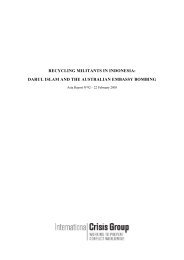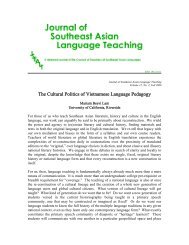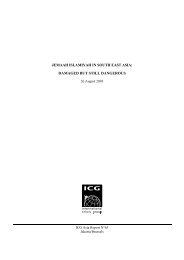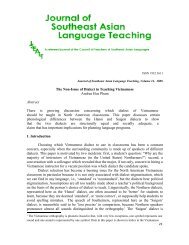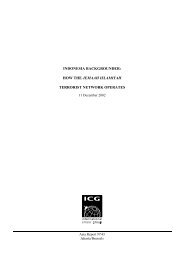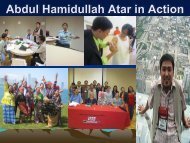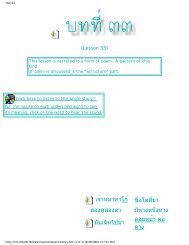Introduction - SEAsite - Northern Illinois University
Introduction - SEAsite - Northern Illinois University
Introduction - SEAsite - Northern Illinois University
You also want an ePaper? Increase the reach of your titles
YUMPU automatically turns print PDFs into web optimized ePapers that Google loves.
Prentation Abstracts<br />
insufficient budget for implementation and lack of capacity building by local officials<br />
may lead to them. By changing the viewpoint, however, it appears that local<br />
forestry officials carry out the “slippage” way for keeping the livelihood of local<br />
people. Although local people do not follow the regulation, land-use pressures on<br />
the land and forests in the study area are still relatively small because of the local<br />
people’s sustainable land- and forest-use practices as well as enough land for<br />
cultivation. Therefore, local official do not need to control them all.<br />
National policies such as land and forest allocation program should been<br />
fixed strictly. However, the real land and forest use in village have various ways.<br />
Therefore, implementation of the policy by local officials should need the flexibility,<br />
which includes “slippage” way.<br />
Grégory Kourilsky* and Vincent Berment**<br />
Towards a Computerization of the Lao Tham System of Writing<br />
* INALCO<br />
** INALCO and GETA-CLIPS (IMAG)<br />
France<br />
Although the subject of under-resourced languages is a problem often taken<br />
into consideration, one omits to make the distinction with under-resourced scripts.<br />
The Tham script of Laos, used to write Buddhist Texts, is one of the two official<br />
writing systems used in Lao P.D.R. (Laos). But if the other one — the so-called<br />
“laic” Lao script — is now quite well computerized (numerous fonts, input software,<br />
word processors, Unicode area), the Tham script seems to have always been<br />
forsaken by modern technologies (typewriters and computers). And this phenomenon<br />
does not seem to be being reversed soon since the Unicode Standard does<br />
not integrate it in any zone. Understanding the sociological and technical reasons<br />
of this neglect, we present an approach to mend it:<br />
• Distinction between two “sub-writing” systems, each working in its own manner:<br />
• P-Tham (Tham transcribing the Pali language),<br />
• L-Tham (Tham transcribing the Lao language),<br />
• Comparison between two families of input methods and selection of<br />
one of them:<br />
• Indic,<br />
• Thai-Lao,<br />
• Proposal of a Unicode chart for the Tham script (presented in the Private<br />
Area Zone”).<br />
Then we describe the tools we developed for entering Tham text in a word<br />
processor:<br />
• A “Unicode” font called Tham Unicode,<br />
• A Microsoft Word add-in called ThamWord that allows typing “Unicode”<br />
Tham.<br />
We finally present another tool that could be developed in the future, that is<br />
a collaborative web site aimed at building L-Tham and P-Tham dictionaries online.<br />
Véronique de Lavenere<br />
The mouth organs of Laos : an instrumental constant at the<br />
heart of this complex ethnic and cultural diversity<br />
Ethnomusicologue, Docteur en Musique et musicologie de Paris IV Sorbonne,<br />
CRLM (Centre de Recherche sur les Langages Musicaux- Paris Sorbonne),<br />
France<br />
The khène, Lao mouth organ, is most widely spread instrument and the most<br />
representative of Lao culture. The Loa people themselves consider it as their guenine<br />
musical heritage although it is found in different forms among various populations<br />
stemming from the four major ethnolinghistic families present in Laos. It<br />
appears thus as « an instrumental constant at the heart of this complex ethnic and<br />
cultural diversity ».<br />
A comparative study of the mouth organ music in one or two populations belonging<br />
of each of these four major ethnomlinguistic families allows to approach<br />
this notion of « constant » from many different angles (musicological, organological<br />
and ethnological). Thus one can adress questions of the similarity and specificity,<br />
of the common musical language, as well as the problems of the evolution of<br />
music and the eventual relations between the specific musical traits and the notion<br />
of « historic layer ».<br />
Les orgues à bouche du Laos : une constante instrumentale au coeur d’une<br />
multi-ethnicité et d’une diversité culturelle<br />
Résumé:<br />
Le khène, orgue à bouche Lao, est l’instrument le plus populaire et le plus<br />
représentatif de cette population. Considéré par les Laos eux-mêmes comme leur<br />
véritable patrimoine, il se retrouve cependant sous différentes formes dans plusieurs<br />
populations issues des quatre grandes familles ethnolinguistiques présentes<br />
au Laos. Il apparaît alors comme « une constante instrumentale au cœur d’une<br />
multi-ethnicité et d’une diversité culturelle ».<br />
Une étude comparative de la musique d’orgue à bouche d’une ou deux populations<br />
appartenant à chacune de ces quatre grandes familles ethnolinguistiques<br />
présentes au Laos, permet d’aborder cette notion de « constante » sous de multiples<br />
angles (musicologique, organologique et ethnologique). Se poseront alors<br />
les questions de similitude et spécificité, de langage musical commun (un système<br />
musical de l’orgue à bouche ?) mais aussi le problème de l’évolution des musiques<br />
et des rapports éventuels entre les traits musicaux spécifiques et la notion de «<br />
couche historique ».<br />
Mai Na M. Lee<br />
Touby Lyfoung and the Emergence of Youthful<br />
Leadership Among the Lao Hmong<br />
PhD Candidate, <strong>University</strong> of Wisconsin—Madison, Wisconsin<br />
In 1939, with the consent of the Hmong clan leaders in the region of Nong<br />
Het, the French and Lao authorities in Xieng Khouang named Touby Lyfoung the<br />
tasseng of Keng Khoai, presiding over the prestigious position once held by the<br />
legendary Kaitong Lo Blia Yao. Touby was just twenty-one years old. In a society<br />
that honored age and experience, Touby’s nomination was unprecedented. His<br />
appointment marked the appearance of youthful leaders among the Lao Hmong.<br />
This paper examines the elements that made the Hmong accept Touby Lyfoung as<br />
a leader despite his tender age. It is argued that literacy and knowledge of multiple<br />
languages, both of which made Touby the ideal political broker for the Hmong,<br />
opened the door for him to become a paramount Hmong leader. Touby’s rise, albeit<br />
seemingly unprecedented, also has roots in Hmong history and society. Touby’s<br />
charisma and literate power tied him to prophetic Hmong leaders in the past, making<br />
him appealing to the Hmong.<br />
Amey Libman, Bounhong Southavong**, Kongmany Sydara**,<br />
Somsanith Bouamanivong**, Charlotte Gyllenhaal*, Mary<br />
Riley*, Doel Soejarto*.<br />
The Influence of Cultural Tradition and Geographic Location<br />
on the Level of Medicinal Plant Knowledge Held by Various Cultural<br />
Groups in Laos<br />
<strong>Illinois</strong><br />
*Program for Collaborative Research in the Pharmaceutical Sciences (PCRPS),<br />
College of Pharmacy, <strong>University</strong> of <strong>Illinois</strong> at Chicago, 833 S. Wood St., Chicago,<br />
IL 60612<br />
**Traditional Medicine Research Center, Ministry of Health, Vientiane, Lao<br />
People’s Democratic Republic<br />
The tradition of using plants as medicine is something that is passed down<br />
from generation to generation within a culture. The country of Laos is inhabited<br />
by approximately 5 million people who are defined by an extremely varied cultural<br />
makeup. The government classifies its citizens into three major cultural groups<br />
based mainly on geographic location; the Lao Loum, the Lao Theung, and the<br />
Lao Sung, which are then broken down further into 47 ethnic subgroups. From<br />
an ethnolinguistic point of view, however, the people of Laos can be categorized<br />
into anywhere from 120 to 200 different ethnic subgroups. The tradition of using<br />
plants to treat common diseases continues to be widely practiced in Laos due to<br />
the fact that many communities have little or no access to the most contemporary<br />
and technologically advanced forms of medicine. Different cultural groups may<br />
possess different traditions for the usage of plants as medicine. Since 1998, an<br />
International Collaborative Biodiversity Group (ICBG) Project, with consortium<br />
members in Vietnam and Laos, has been working in collaboration with the Lao






